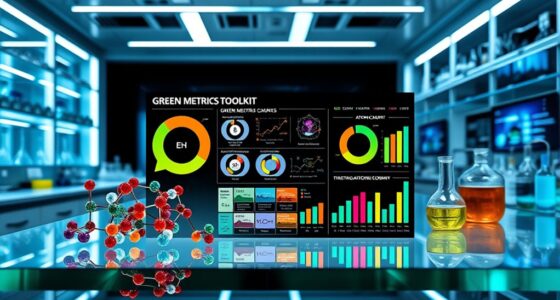Sustainable dyes in textiles include plant-based pigments, microbial innovations, and advanced digital processes that reduce environmental impact. You can benefit from natural dyes derived from flowers, leaves, and roots, which are biodegradable and eco-friendly. Innovations like bioengineered microbes and algae-based dyes further lower water use and pollution. Cutting-edge technologies optimize dyeing processes for efficiency and sustainability. Continue exploring to discover how these advancements are shaping eco-friendly fashion and textile manufacturing.
Key Takeaways
- Plant-based pigments like madder root, indigo, and turmeric offer eco-friendly, biodegradable dye options for sustainable textiles.
- Microbial and bioengineered dyes reduce reliance on petrochemicals and enable fermentative coloring processes.
- Advanced digital and bio-digital technologies optimize dyeing efficiency, reduce water and chemical use, and enhance process sustainability.
- Innovations such as algae-based dyes and microbial upcycling support circularity and decrease environmental impact.
- Challenges include high production costs and raw material variability, requiring policy support and market adoption for scalability.
Exploring Plant-Derived Dyes and Their Natural Appeal

Plant-derived dyes offer a natural and sustainable alternative to synthetic colorings in textiles. You can source these dyes from renewable materials such as flowers, leaves, roots, and bark. For example, madder root provides rich reds, indigo plants yield deep blues, and turmeric offers vibrant yellows.
Some dyes come from insects like cochineal, which produces striking reds and purples. These sources are cultivated without synthetic fertilizers or pesticides, supporting biodiversity and promoting eco-friendly farming practices.
Using plant-based dyes reduces environmental impact because they’re biodegradable, non-toxic, and require less water—often with water reuse options. Their renewable nature helps lower the ecological footprint of textile production, making them a responsible choice for environmentally conscious consumers and manufacturers alike.
Addressing Challenges in Natural Dye Production and Scalability
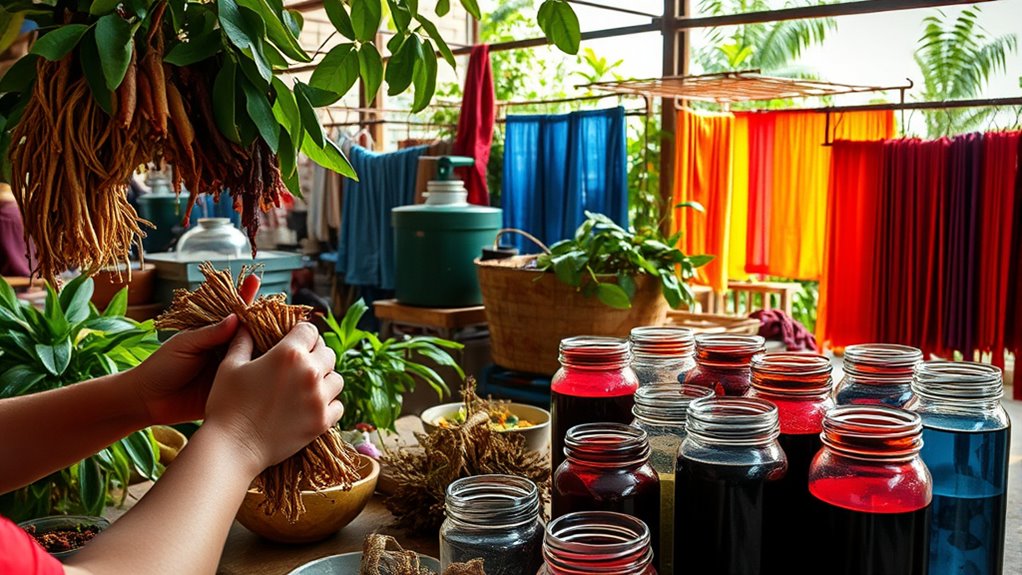
Scaling natural dye production faces significant hurdles that hinder widespread adoption. Variability in soil, rainfall, and temperature affects dye quality and consistency, making it hard to meet industry standards.
The extraction process is labor-intensive and time-consuming, raising costs and limiting efficiency. Raw material prices remain high, adding to the overall expense.
Technological challenges, such as improving extraction methods and dye fastness, further complicate scaling efforts. Additionally, natural dyes demand substantial water and energy, especially for repeated batches, raising sustainability concerns.
Achieving consistent shades and durable colors is difficult due to environmental fluctuations and plant variability. While research into advanced extraction and biomordants continues, these issues collectively pose significant barriers to large-scale adoption, requiring innovation and investment to overcome. Moreover, storage conditions such as temperature and light exposure can impact dye stability and longevity, complicating the production process further. Addressing these challenges requires a focus on sustainable practices and innovations in production methods to improve scalability and environmental impact. For instance, recent developments in biomordants show promise in enhancing dye fastness and reducing chemical use.
Innovations in Eco-Friendly Synthetic Dyes and Their Role in Sustainability
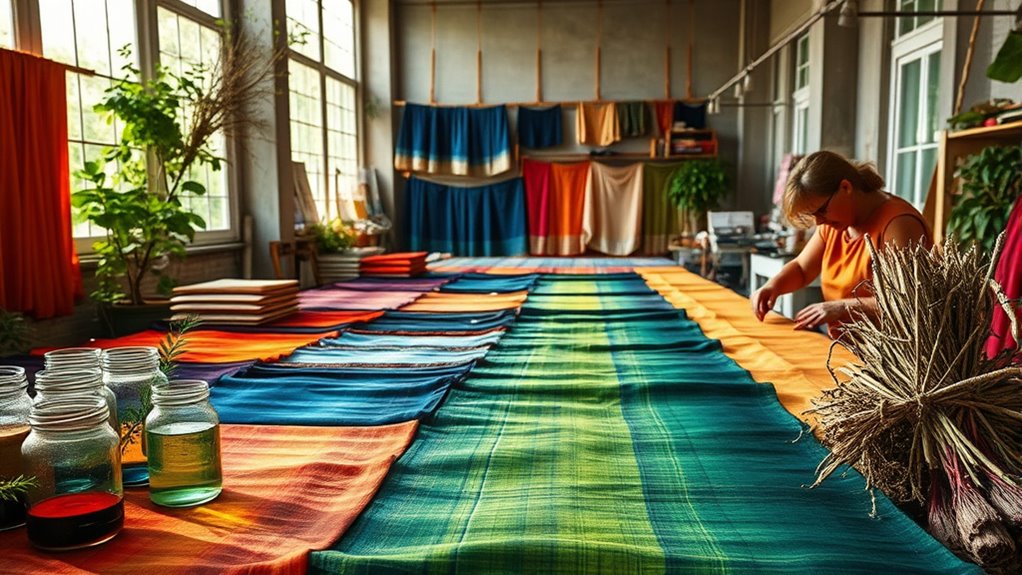
Innovations in eco-friendly synthetic dyes are transforming the textile industry by reducing environmental impact while maintaining vibrant, durable colors. High fixation rates, like 99% dye uptake in polyester, cut waste and effluent pollution.
Eco-friendly synthetic dyes boost fixation rates, reducing waste and pollution in textile production.
New formulations using biodegradable, non-toxic chemicals minimize hazards. Waterless dyeing technologies, such as supercritical CO2 processes, eliminate water use and reduce chemical discharge, with major brands adopting these scalable methods. Additionally, process improvements like enhanced fixation, automation, and closed-loop systems further reduce waste and resource consumption.
Microbial and bioengineered dyes, produced by genetically engineered bacteria, mimic synthetic dye properties with lower environmental footprints and lessen reliance on petrochemicals.
Understanding market research helps manufacturers identify sustainable dye options that meet consumer demand for eco-friendly products.
Furthermore, adopting innovative dyeing techniques can significantly decrease the overall environmental footprint of textile manufacturing. These innovations collectively advance sustainable practices, making synthetic dyes more eco-friendly and supporting the industry’s move toward greener, more efficient textile production.
Cutting-Edge Technologies Transforming Textile Dyeing Processes
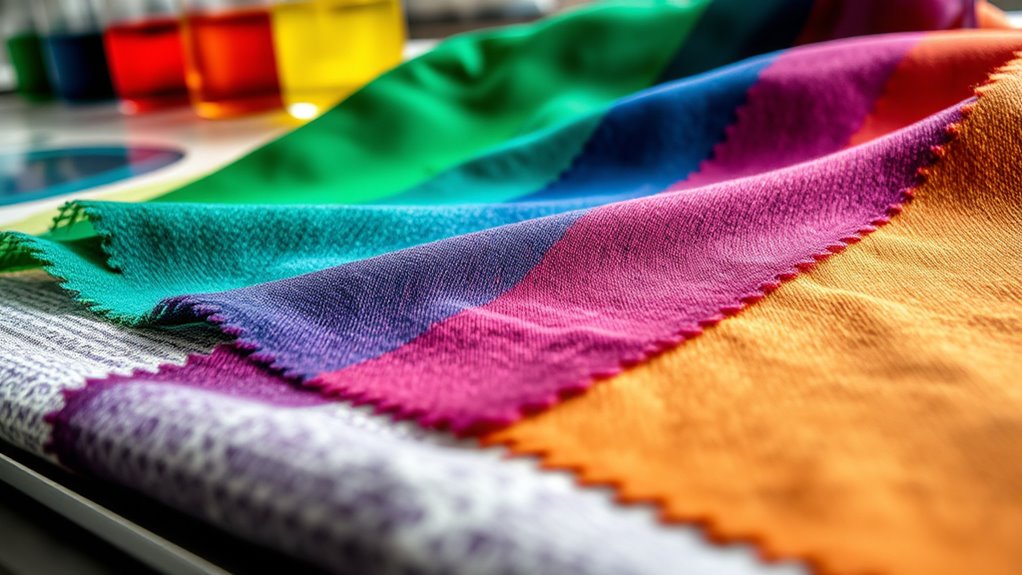
Advancements in textile dyeing technologies are revolutionizing how fabrics are colored, making processes more efficient and eco-friendly. SpinDye technology, for instance, adds pigment to synthetic fibers before production, cutting water use by 75% and chemicals by 90%. Incorporating sustainable practices ensures that these innovations support environmental health and long-term industry viability. Digital textile dyeing reduces energy consumption by up to 85% and wastewater by 95%. AI-powered machines optimize water and chemical use in real-time, minimizing waste, while digital twin technology simulates processes virtually to prevent resource waste. Environmental impact considerations are increasingly integrated into these technological advancements to promote sustainability. Precision application methods like nanodroplet technology improve color penetration and durability, supporting various fabrics at faster speeds. These innovations also lower operational costs—up to 50%—by boosting efficiency and reducing maintenance. Additionally, implementing renewable energy sources can further enhance the sustainability of textile dyeing operations.
Environmental Benefits of Sustainable Dyes in Reducing Resource Consumption
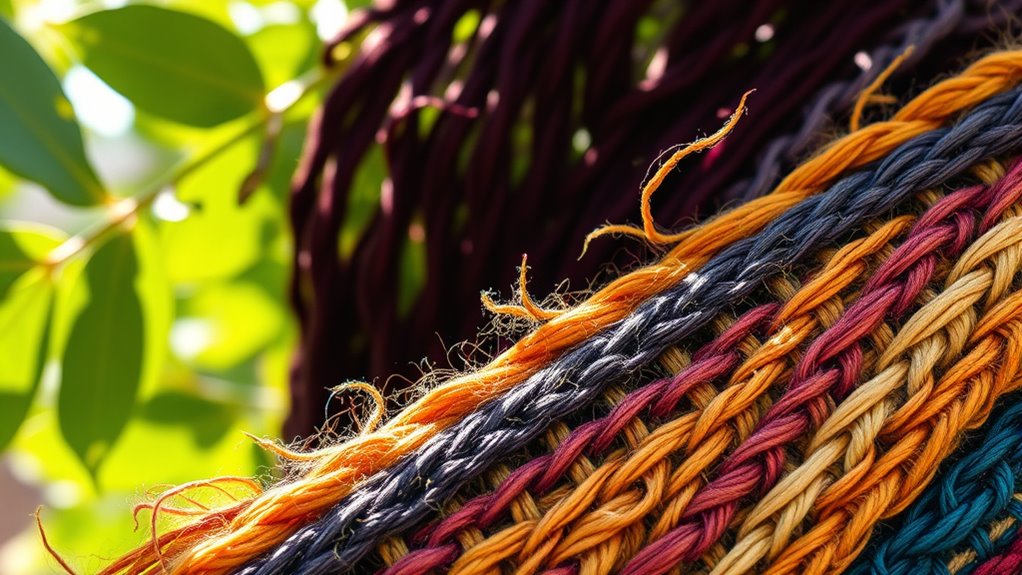
Sustainable dyes offer significant environmental benefits by reducing resource consumption in textile production. They typically need less water, cutting down on water use and easing pressure on local water sources.
Because plant-based dyes generate less hazardous waste, they lower pollution and promote biodegradability, which benefits ecosystems. These dyes are made from renewable plant materials, supporting sustainable resource use.
Additionally, natural dyeing processes often require less energy, decreasing the carbon footprint of textile manufacturing. Less rinsing is needed, and water used can often be recycled for agriculture, further conserving resources. Furthermore, climate change impacts can be mitigated through reduced energy consumption and lower greenhouse gas emissions associated with natural dyeing techniques.
Overcoming Economic Barriers and Enhancing Market Adoption

Despite the clear environmental advantages of sustainable dyes, economic barriers continue to hinder their widespread adoption in the textile industry. High production costs, driven by expensive raw materials and inefficient processes, make sustainable dyes less competitive with synthetic alternatives.
Limited infrastructure and seasonal availability of natural sources increase expenses and supply inconsistencies, discouraging investment. Small and medium enterprises face financial risks due to uncertain returns, while weak policies and lack of incentives reduce motivation to innovate.
Consumer awareness remains low, and higher retail prices create resistance. Complex supply chains, technical challenges, and the high upfront costs of equipment further slow adoption.
To overcome these barriers, you need targeted policies, better market education, scalable technologies, and financial support to make sustainable dyes more accessible and economically viable.
Future Directions: Biotechnology, Digital Printing, and Emerging Materials

Innovations in biotechnology, digital printing, and emerging materials are transforming how you produce and apply dyes in the textile industry. Microbial pigments made from genetically modified bacteria and fungi now create biodegradable dyes with less chemical waste.
CRISPR gene editing speeds up discovering new pigment-producing microbes, while fermentative dyeing allows microbes to color fibers during growth, eliminating traditional dye baths.
Algae-based dyes reduce water use and improve biodegradability.
Advanced digital printing offers precise, customizable application that cuts water use by up to 90%, reduces waste, and lowers energy consumption.
Engineered biomaterials like protein-enhanced fibers and self-pigmenting textiles improve dye retention and vibrancy.
Hybrid bio-digital systems, microbial upcycling, and bioinks further push sustainability, enabling you to adopt innovative, eco-friendly dyeing methods.
Frequently Asked Questions
How Do Sustainable Dyes Compare in Colorfastness to Traditional Dyes?
You might notice that sustainable dyes often fade faster than traditional dyes over time. Their colorfastness can be improved with mordants and better technology, but exposure to sunlight and washing still impact their durability.
While they’re eco-friendly and safer for health, their limited color range and scalability pose challenges. Still, ongoing innovations are helping these dyes approach the performance of synthetic options, making them more viable for long-lasting applications.
What Are the Main Environmental Impacts of Large-Scale Natural Dye Production?
You should know that large-scale natural dye production impacts the environment mainly through high water use, leading to potential water pollution from untreated wastewater containing plant residues and heavy metals from mordants.
It can also cause soil degradation from crop cultivation and mordant accumulation. Additionally, energy-intensive processing and transportation increase carbon emissions.
Proper waste management and eco-friendly practices are essential to minimize these environmental impacts and protect ecosystems.
Are There Certifications to Verify the Sustainability of Dyes Used in Textiles?
You want to know if there are certifications that verify the sustainability of dyes used in textiles. Rest assured, multiple certifications exist to give you confidence.
SNDS certifies natural dye content and holistic sustainability.
GOTS ensures eco-friendly dyeing processes and social responsibility.
OEKO-TEX guarantees product safety from harmful dyes.
Combining these certifications provides an all-encompassing verification, helping you make informed choices and support truly sustainable textile practices.
How Does Consumer Perception Influence the Adoption of Sustainable Dye Products?
Your perception greatly influences the adoption of sustainable dye products. When you see brands being transparent and committed to eco-friendly practices, you’re more likely to trust and choose their products.
Education about the benefits of sustainable dyes also boosts your awareness, encouraging you to make environmentally conscious purchases.
Ultimately, your value for sustainability and brand loyalty drive the demand for greener dyes, pushing companies to innovate and prioritize eco-friendly options.
What Role Do Government Policies Play in Promoting Eco-Friendly Dyeing Practices?
Think of government policies as the compass guiding the textile industry toward sustainability. They set regulations that limit harmful chemicals, offer incentives for eco-friendly practices, and promote transparency through eco-labels.
These policies encourage manufacturers to innovate with plant-based dyes and circular economy laws, making sustainable dyeing the norm. By enforcing standards and supporting green technologies, governments help guarantee that eco-conscious choices become accessible, affordable, and widespread.
Conclusion
Imagine weaving a future where every thread tells a story of care for our planet. By embracing plant-based dyes and innovative technologies, you can help turn the textile industry into a vibrant canvas of sustainability. Just as a single drop of dye transforms fabric, your choices can spark a ripple of change. Together, we can color our world with hope, making eco-friendly textiles the new standard for generations to come.





